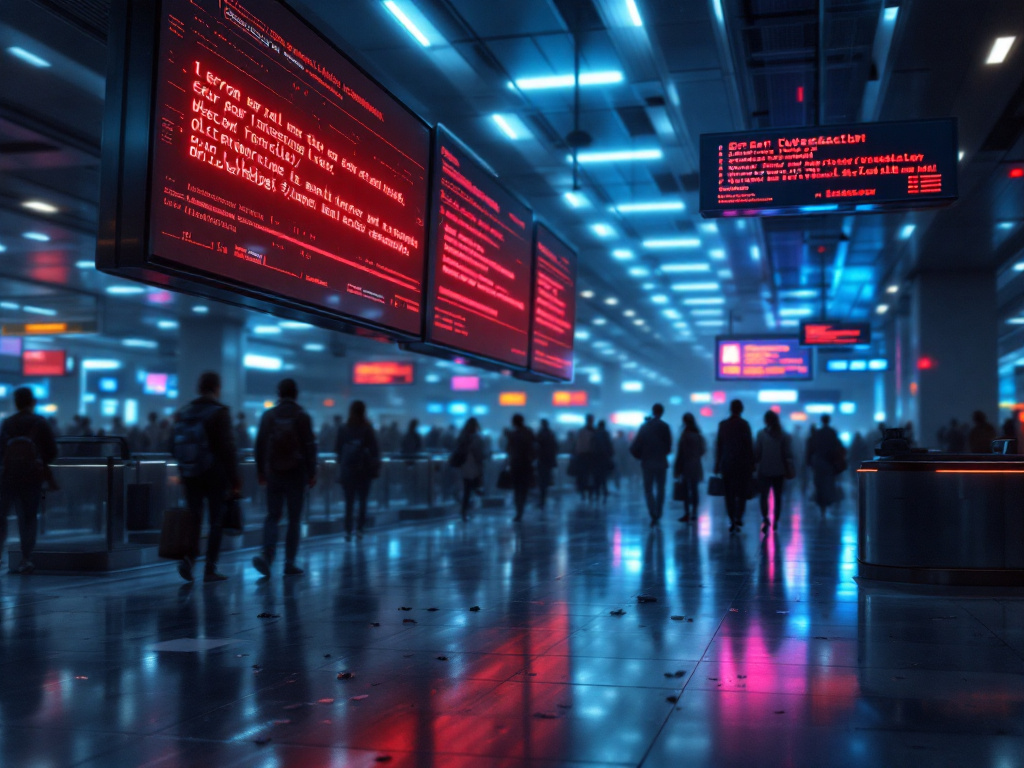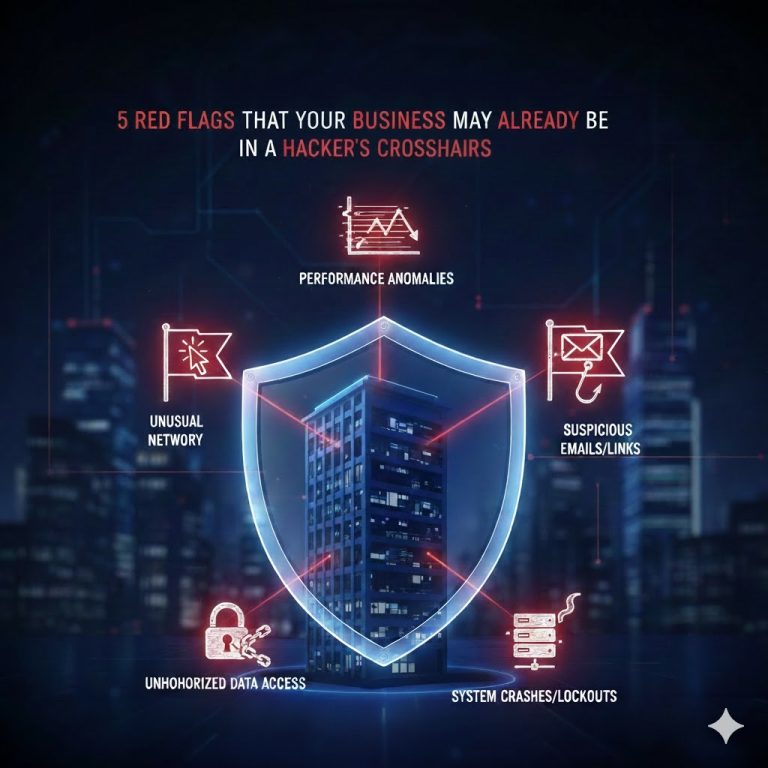Imagine arriving at the airport for an important business trip or long-awaited holiday. Instead of smooth check-in counters and efficient boarding, you’re greeted by endless queues, frustrated passengers, delayed flights, and staff frantically scribbling passenger names onto paper lists. Baggage piles up, planes can’t depart on time, and the entire logistics chain starts to collapse.
This isn’t a scene from a dystopian movie — it’s what happened at Berlin Brandenburg Airport (BER) and several other major European hubs in September 2025. A cyberattack against Collins Aerospace, a major service provider, disrupted critical airport systems across Europe. Check-in software and baggage systems failed simultaneously, forcing airports to revert to manual processes. The result: chaos for thousands of passengers, missed connections, and significant financial losses.
What makes this incident even more alarming is that the airport itself was not directly hacked. Instead, the weakness lay in a third-party vendor. This highlights a critical truth about our modern, interconnected world: our dependence on digital infrastructure is only as strong as its weakest link.
When a single cyberattack can bring multiple international airports to a standstill, it reveals just how fragile our systems really are. And while airports grab headlines because of the immediate impact on travelers, the same vulnerabilities exist in hospitals, banks, factories, and energy grids.
Digital dependence – a double-edged sword
Digitalization has revolutionized the way airports and airlines operate. For passengers, it often feels seamless: online check-ins, boarding passes on smartphones, baggage tags printed in seconds, and real-time flight updates delivered straight to your inbox. For airlines and operators, these systems mean greater efficiency, reduced staffing costs, and better capacity management.
-
Automated check-in and boarding systems allow airports to process tens of thousands of passengers each day without overwhelming staff. What once required long manual procedures is now a matter of scanning a QR code.
-
Real-time logistics and cargo management ensure that goods, from medical supplies to luxury products, are tracked minute by minute. A single delay in cargo handling can ripple through global supply chains — but digital tools usually prevent that.
-
Customer experience and personalization have improved dramatically. From self-service kiosks to AI-powered rebooking systems, travelers now expect convenience as the norm.
But this remarkable progress comes with a hidden cost: dependency. When every link in the chain is digital, even a small disruption can have an outsized impact. The BER incident showed this clearly: the airport itself wasn’t directly hacked, yet a single supplier’s failure caused massive breakdowns in check-in and baggage handling. What should have been a localized IT problem cascaded into an international crisis, stranding passengers across multiple countries.
This paradox defines our era: the more we automate and interconnect, the more efficient we become — but the more vulnerable we are when things go wrong. Systems that were designed to eliminate human error can fail catastrophically when the technology they rely on is compromised. Unlike in the past, where a single broken conveyor belt or lost paper logbook affected only one terminal, today’s interconnected platforms can spread disruption instantly across entire networks.
In other words, digitalization hasn’t just made travel smoother — it has also multiplied the potential points of failure. Airports, airlines, and even passengers themselves are now part of a delicate ecosystem where resilience matters just as much as innovation.
Where the weak points are
The cyber incident at BER didn’t expose a brand-new threat — it highlighted weaknesses that have been known for years but are still underestimated across industries. When systems are so tightly interconnected, a single flaw can trigger widespread disruption.
-
Legacy IT systems
Many airports and airlines still rely on decades-old software that was never designed to withstand today’s cyber threats. Patching is often delayed due to the complexity of operations or fear of downtime. But the cost of postponing upgrades is high: outdated systems become an open door for attackers. In critical infrastructure, “if it works, don’t touch it” is a dangerous mindset. -
Human error
No matter how advanced technology becomes, people remain the most common entry point for cyberattacks. Phishing emails, weak passwords, or misconfigured accounts can compromise even the most secure networks. Attackers know this and often choose the path of least resistance — tricking an employee into clicking one malicious link can be far more effective than hacking a firewall. -
Complex supply chains
Airports don’t operate in isolation. Dozens of service providers — from baggage handling to catering, from fuel suppliers to IT vendors — form a vast digital ecosystem. Every one of these partners represents a potential entry point for attackers. The BER incident demonstrated this clearly: the airport’s own IT wasn’t breached, but a supplier’s vulnerability was enough to bring operations to a halt. In cybersecurity, a chain is only as strong as its weakest link. -
Ransomware & DDoS attacks
Modern attackers don’t always aim to steal data; sometimes, they just want to disrupt. Ransomware can encrypt systems, holding them hostage until money is paid. Distributed Denial of Service (DDoS) attacks flood servers with traffic until they crash. Both approaches are relatively easy for cybercriminals to launch, but their consequences for highly digitized environments like airports are devastating — grounded planes, missed connections, and angry passengers.
The BER case is a textbook example of how these risks converge. The airport’s own IT wasn’t hacked, but the dependency on an external provider (Collins Aerospace) turned into a critical vulnerability. Once their systems failed, check-in counters and baggage handling collapsed instantly. Staff had no choice but to revert to paper lists and manual tracking. While this emergency fallback prevented a complete shutdown, it slowed processes dramatically, created confusion, and left thousands of passengers stranded or delayed.
What should have been a contained IT issue became a large-scale operational crisis — not because of the size of the attack, but because of the fragility of the digital ecosystem that modern airports rely on.
What other companies can learn from the incident
The BER incident offers a sobering but valuable lesson: the weakest link in a digital chain can bring down the entire system. And in an era where airports are hubs not only for passengers but also for global trade and security, such vulnerabilities carry consequences far beyond a single day of delays.
One of the key takeaways is that cybersecurity is no longer a technical issue for IT departments alone. It is a boardroom-level responsibility. Business leaders must recognize that digital risks directly translate into financial losses, reputational damage, and even national security concerns. When planes are grounded, airlines lose revenue by the minute, passengers lose trust, and governments face public pressure to intervene.
Another lesson is the importance of supply chain resilience. The attack didn’t hit BER directly, but it still crippled operations. This shows that organizations must look beyond their own walls. It’s not enough to secure internal systems; businesses must demand the same level of vigilance from their partners and service providers. Vendor contracts should include clear security requirements, independent audits, and contingency plans.
The incident also demonstrates the need for redundancy and well-practiced fallback procedures. At BER, staff had to revert to paper-based processes under pressure. While this prevented a total shutdown, the transition was slow and chaotic because it wasn’t a rehearsed scenario. In high-stakes environments, resilience is not just about having backup systems, but about making sure employees know exactly how to use them under stress. Regular drills and tabletop exercises can make the difference between controlled disruption and total collapse.
Finally, BER underscores the broader point that cyberattacks are not rare events anymore — they are inevitable. Organizations that treat them as hypothetical “what ifs” will always be caught off guard. The shift in mindset must be toward “when, not if.” Preparedness, rapid response, and recovery capabilities are just as critical as prevention.
In short, the lessons are clear:
-
Cybersecurity must be treated as a strategic priority.
-
Supply chains must be scrutinized and secured.
-
Backup plans must be tested, not just documented.
-
And above all, organizations must build resilience into their DNA — because in a hyper-connected world, disruption is only ever one weak link away.
How companies can protect themselves
| Area | Action Steps | Why it matters |
|---|---|---|
| Supplier & Third-Party Management | – Conduct risk assessments before onboarding vendors. – Demand regular security audits & certifications (ISO 27001, SOC2). – Define SLAs and emergency protocols in contracts. |
BER wasn’t hacked directly — but suffered from its supplier’s downtime. Strong vendor controls reduce indirect risks. |
| Redundancy & Resilience | – Maintain backup systems and manual fallback processes. – Design IT to “degrade gracefully” rather than fail completely. – Test offline or isolated operating modes. – Keep critical data in both cloud and on-prem backups. |
Switching to paper lists worked, but slowly. Practiced fallback systems mean faster recovery. |
| Cybersecurity Basics | – Enforce strict patch management. – Apply network segmentation to isolate critical systems. – Adopt Zero-Trust principles. – Use MFA and least-privilege access. |
Prevents attackers from exploiting outdated systems or moving laterally once inside. |
| Monitoring & Incident Response | – Continuous monitoring (SIEM, logging, anomaly detection). – Regular penetration testing and red-teaming. – Clear business continuity plans: who does what if systems fail? – Run tabletop exercises for real-world readiness. |
Faster detection and a trained response reduce chaos in emergencies. |
| Communication & Training | – Transparent updates to customers when disruptions occur. – Internal communication protocols for quick action. – Train employees to handle crises and fallback processes smoothly. |
At BER, passengers faced confusion. Clear communication reduces stress and reputational damage. |
| Compliance & Insurance | – Stay ahead of regulatory requirements for critical infrastructure. – Cyber insurance with incident response support. – Participate in industry-wide security initiatives. |
Compliance strengthens defenses; insurance helps cushion financial impact. |
Why this concerns everyone
Airports may dominate the headlines because their disruptions are so visible: stranded passengers, missed flights, and chaotic terminals. But in reality, they are just one piece of a much larger puzzle. Every sector that forms the backbone of our society now relies on digital infrastructure.
-
Hospitals and healthcare systems depend on connected medical devices, patient databases, and telemedicine platforms. A cyberattack here can delay treatments, block access to life-saving data, or even endanger lives directly.
-
Banks and financial institutions process millions of transactions every second. If their systems fail, entire economies can grind to a halt. Trust in financial stability — the cornerstone of modern society — can evaporate overnight.
-
Logistics and supply chains are orchestrated digitally, from shipping containers tracked via GPS to warehouse robots controlled by cloud systems. An outage doesn’t just slow deliveries; it can paralyze global trade.
-
Energy providers and utilities manage power grids, water supplies, and heating systems through complex digital networks. A targeted attack could plunge cities into darkness, disrupt industries, and threaten public safety.
What the BER incident makes painfully clear is this: an outage is no longer just an inconvenience — it is a systemic risk. When critical systems go offline, the consequences cascade. Passengers miss flights, but also businesses lose contracts, families miss important events, and supply chains falter. Extrapolate that to hospitals or power plants, and the stakes rise exponentially.
The truth is that cyberattacks are no longer rare, isolated events. They are part of the new normal — increasingly sophisticated, often state-sponsored, and sometimes simply designed to cause chaos. The key question for organizations is no longer if they will be targeted, but when — and how well they will respond when the inevitable happens.
In this sense, the BER disruption should not be dismissed as just another airport glitch. It is a wake-up call for every industry, every government, and every individual who depends on technology — which, in today’s world, means all of us.
Conclusion: Airport cyberattack 2025 – how vulnerable our systems
The airport cyberattack of 2025 is more than just a disruption in air travel — it is a stark reminder of how vulnerable our interconnected systems truly are. What happened at BER shows that a single weak point in a service provider can ripple across entire networks, grounding planes, stranding passengers, and damaging trust.
The lesson is clear: in a world where airports, hospitals, banks, logistics, and energy grids all depend on digital infrastructure, resilience is no longer optional. Cyberattacks are not rare exceptions but part of the new normal. The question is no longer if our systems will be tested, but how prepared we are when the attack comes.
Organizations that invest now — in stronger cybersecurity, resilient supply chains, and well-practiced contingency plans — will not only survive such incidents but emerge stronger. Those who ignore the warning may find themselves the next headline.
Please also read:
All computers locked – what to do in the event of a ransomware attack?
Cybersecurity 2025: The Biggest Risks for Businesses – and How to Protect Your Company
Why Virus Protection Alone Is Rarely Enough – and Why Knowledge Is the Key
Follow me on Facebook or Tumblr to stay up to date.
Connect with me on LinkedIn
Take a look at my services
And for even more valuable tips, sign up for my newsletter





